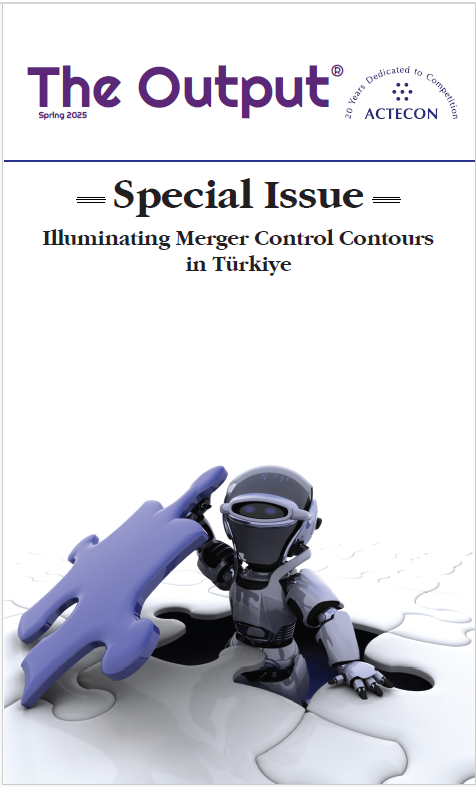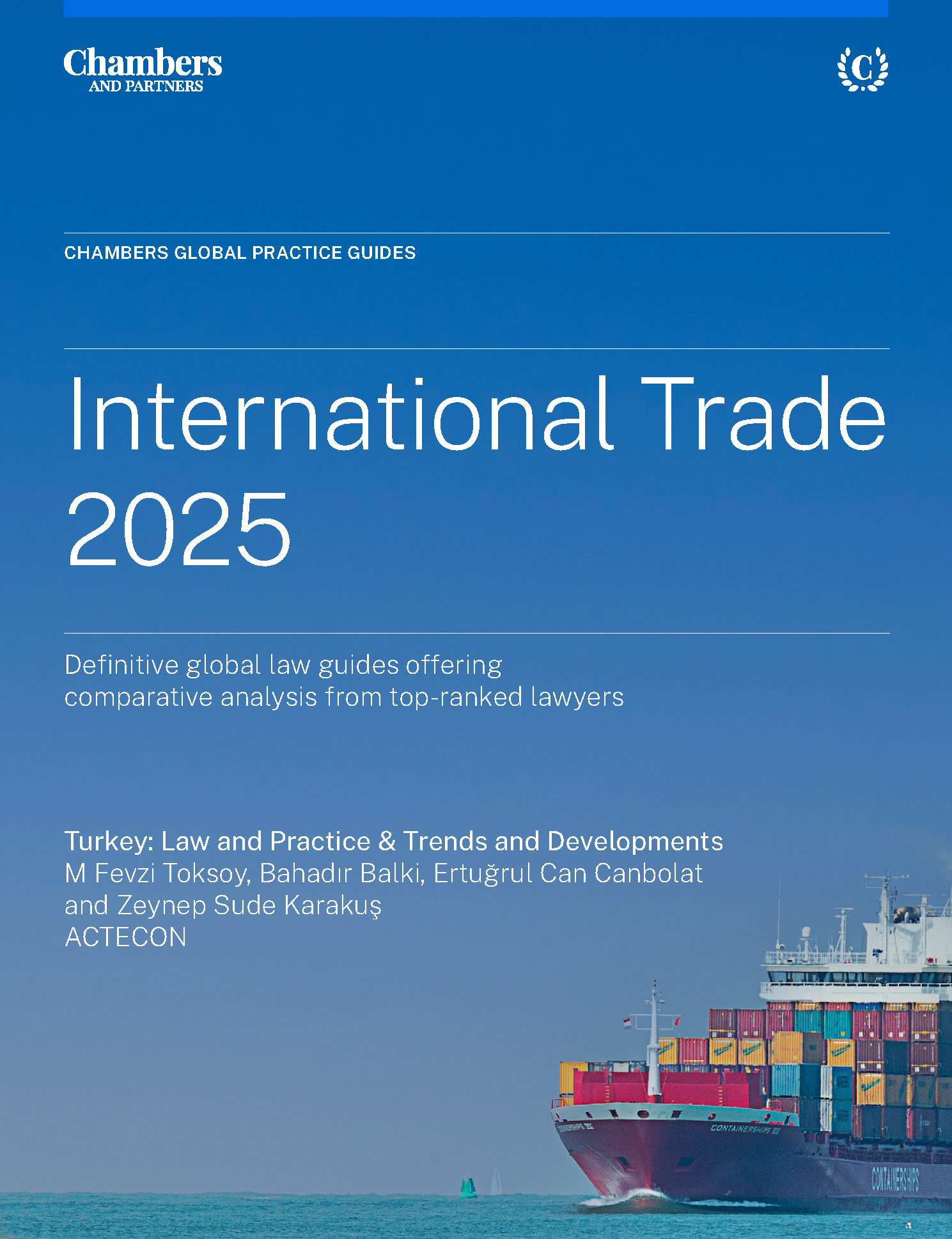Towards a More Effective Enforcement? - Turkish Competition Authority Steps into the Realm of De Minimis
| Competition Law

Towards a More Effective Enforcement? - Turkish Competition Authority Steps into the Realm of De Minimis
Article by Erdem Aktekin, Nabi Can Acar, and Doğa Küçükay
1. Introduction
On 23.10.2020, the Turkish Competition Authority (“TCA”) published a draft of its long-awaited Communiqué on Agreements, Concerted Practices, and undertaking association decisions of minor importance which do not appreciably restrict competition (“Draft Communiqué”) modelled after the European Commission’s (“EC”) De Minimis Notice (2014/C 291/01) (“De Minimis Notice”). The TCA is now accepting opinions and comments from various stakeholders on the matter until the deadline of 23.11.2020.
Hereby we provide highlights of the Draft Communique, as well as analysis of the main crucial points.
At the first glance, the Draft Communiqué seems only to exclude certain type of agreements from its scope (i.e. a certain portion of its cartel definition provided in Active Cooperation/Leniency Regulation[1]), while covering mostly other object restrictions. In other words, the TCA seems to be of the opinion that object restrictions, where they are deemed inappreciable, would not be harmful to the end consumers. On this point, the TCA seems to be diverting from the EC’s practice. This might seem peculiar given the TCA’s aptitude in following the case law of the EC. However one must also keep in mind that the Communiqué is currently only a draft. Furthermore, excluding object restrictions from the scope of de minimis might very well be a policy decision made by the TCA.
Starting by comparing the notion of object restriction of the two jurisdictions, i.e. the EC’s and the TCA’s, this article aims to make a short comparison between the Draft Communiqué and its European counter-part, while at the same time providing the audience with some background on the Expedia Judgement, in which the Court of Justice (“CJ”) cemented the approach towards the concept of de minimis.
We argue, due to the wording of the Draft Communiqué, undertakings can now argue that their agreements are indeed restrictive by object but they do not appreciably restrict competition. For example, the undertakings can engage in resale price maintenance (“RPM”) or internet sale bans and defend their agreements if the market shares of the parties fall within the scope of the safe harbour envisaged by the Draft Communiqué. (Unlike the case in the EU). Moreover, the discretion awarded to the TCA to initiate proceedings in any case even the market share threshold is met and the relatively vague and narrow[2] definition of “explicit and hardcore” further creates ambiguity. In its current form, the Draft Communiqué is very ambiguous, and it leaves several questions unanswered.
- Restriction by object:
Pursuant to the TCA’s Guidelines on Horizontal Co-operation Agreements (“Guidelines”), when an agreement restricts competition by object, constitutes a violation under Article 4 of The Act No. 4054 On the Protection of Competition (“Competition Law”) by its nature. It is not necessary to analyse the actual or potential effects of the relevant agreement on the market.
However, when assessing whether an agreement restricts competition by object, the contents of the agreement, the objectives it is trying to attain, and the economic and legal framework in which exists must be taken into consideration.[3] If after this analysis it decided that the agreement does not restrict competition by object, it must be examined whether it has restrictive effects on competition.[4] Accordingly, the concept of object restriction does not differ between Turkey and EU, nor does the practices deemed as object restrictions such as price fixing cartels, RPM agreements or agreements to ban internet sales.
- De Minimis:
Agreements of minor importance which do not appreciably restrict competition under Article 101(1) TFEU or simply De Minimis, are those agreements that satisfy the criteria set by the relevant notice..
The EC holds the view that agreements between undertakings which may affect trade between Member States and which may have as their effect the prevention, restriction or distortion of competition within the internal market, do not appreciably restrict competition within the meaning of Article 101(1) of the Treaty if:
- The aggregate market share held by the parties to the agreement does not exceed 10% on any of the relevant markets affected by the agreement, where the agreement is made between undertakings which are actual or potential competitors on any of those markets (horizontal agreements)
OR
- The market share held by each of the parties to the agreement does not exceed 15% on any of the relevant markets affected by the agreement, where the agreement is made between undertakings which are not actual or potential competitors on any of those markets (vertical agreements)[5]
It should be noted that the approach of the Draft Communiqué to appreciability based on market shares entirely mimics the EC’s approach. [6]
- Differences between the two jurisdictions:
However, though the appreciability criteria seems to be alike, there are some major differences between Draft Communiqué’s approach to the concept of de minimis and that of EU’s. One difference that can be found between the two is how they treat object restrictions. The EC’s De Minimis Notice explicitly asserts that object restrictions will not benefit from the safe harbour created by de minimis notice. Indeed, pursuant to the notice:
“The Court of Justice has also clarified that an agreement which may affect trade between Member States and which has as its object the prevention, restriction or distortion of competition within the internal market constitutes, by its nature and independently of any concentrate effects that it may have, an appreciable restriction of competition. This Notice therefore does not cover agreements which have as their object the prevention, restriction or distortion of competition within the internal market”.[7]
This approach provided in the Notice is set by the Expedia judgement of the Court of Justice of the European Union (“CJEU”). In Expedia, the referring court asked to the CJEU whether a national competition authority (“NCA”) was precluded from applying Article 101(1) TFEU to an agreement between undertakings that may affect trade between Member States, but that does not reach the threshold specified by the EC in its de minimis notice.[8] Neither the undertaking Expedia, the French Government nor the EC, in their written observations or during the hearing, questioned the finding by the court that the agreement had an anti-competitive object.[9] The CJEU emphasized that according to the settled case-law, for the purpose of applying Article 101(1) TFEU, there is no need to take account of the concentrate effects of an agreement once it appears that it has as its object the prevention, restriction or distortion of competition.[10] In that regard, the Court has emphasized that the distinction between ‘infringement by object’ and ‘infringement by effect’ arises from the fact that certain forms of collusion between undertakings can be regarded, by their very nature, as being injurious to the proper functioning of normal competition.[11] In light of the above facts, the CJEU decided that object restriction could not benefit from the de minimis notice and the NCA’s were not precluded to apply Article 101(1) TFEU even if the agreements concluded were falling into safe harbour of the de minimis notice.[12]
With this case, the CJEU has buried the idea of any market share-based safe harbour for restrictions by object, thereby converging the case law with the EC’s policy approach. This case also set aside the previous case law such as Franz Völk v Vervaecke.[13]
At a first look, the Draft Communiqué also seems to exclude object restrictions out of its scope. Pursuant to Article 2 of the Draft Communiqué, the Draft Communiqué is applicable to agreements, concerted practices and decisions of undertakings or association of undertakings excluding explicit and hardcore infringements. Thereby, based on the wording, one can infer that object restrictions and cartel agreements does not fall within the Draft Communiqué’s scope.
However, after examining the definition provided in the Draft Communiqué, it can be understood that this is not the case. Article 4 of the Draft Communiqué defines the concept of explicit and hardcore infringements. Accordingly, these infringements are price fixing, customer and territorial allocation and, limiting output. Draft Communiqué’s explicit and hardcore infringement definition covers certain portion of its cartel definition and the basis of it actually comes from the recently amended article 43 of the Competition Law which reads as follows:
“Based on criteria such as market share and turnover, the Board may decide not to initiate an investigation concerning those agreements, concerted practices and decisions and actions of associations of undertakings which do not significantly restrict competition in the market, with the exception of naked and hard-core infringements such as price fixing between competitors, region and customer allocation, and supply restriction. The rules and procedures concerning the application of this paragraph shall be established with a communiqué issued by the Board.”
The foregoing article provided in the Competition Law does not make a “numerus clausus” definition as to the “hard-core infringements”; it only exemplifies types of violations by inserting “such as” at the beginning of price fixing between competitors, region and customer allocation, and supply restriction. Draft Communiqué, however, limits hard-core infringements with price fixing, customer and territorial allocation and, limiting output, which is narrower than the Competition Law’s language and begs the question whether this choice was intentional.
Despite the contradiction between the Law and the Draft Communiqué, the explicit and hardcore infringement categorization further leads up to a blurred area in terms of what type of violations can benefit from the Draft Communiqué. Indeed, if the TCA had only certain portion of its cartel definition on its mind when defining “hardcore and explicit violations”, current case law creates an uncertain landscape mainly because of the TCA’s incoherent approach towards making cartel determinations. Indeed, the TCA's case law is full of decisions that do not consider even explicit violations including price fixing and market allocation as a cartel[14].
This also further begs the question; does this mean that object restrictions, other than certain portion of cartel definition are excluded from the scope of the notice? Judging by the current wording, it does. Take RPM for example. According to the recent case law of the TCA, RPM violates Competition Law by object. In Henkel[15] and Sony[16], decision the TCA clearly established that RPM is a “by object” violation.
The Guidelines on Vertical Agreements[17] also confirms this approach. Paragraph 17 titled “Resale Price Maintenance” of the Guidelines on Vertical Agreements of the TCA stipulates that setting fixed or minimum sales prices for the buyer is absolutely prohibited. This is too the practice in the EU.[18] RPM is allocated to the object box as Professor Whish calls it and the Commission Regulation No 330/2010’s Article 4 titled ‘hardcore restrictions’ states that RPM will remove the benefit of the block exemption.[19]
Another example would be the restriction of passive sales. Pursuant to the Guidelines on Vertical Agreements, the protection provided to undertakings via the grant of an exclusive region or customer group is not absolute. The supplier may restrict active sales but restricting passive sales to a region or a customer group shall be considered an infringement which exclude the agreement from the block exemption.[20] Therefore, restriction of passive sales are too considered object restrictions. We found this more concerning because allowing a ban on passive sales would mean allowing a ban on internet sales. Indeed, the Vertical Guidelines explicitly acknowledges this point.[21] Considering the Covid-19 outbreak, allowing undertakings to ban internet sales may reveal catastrophic results. The TCA must also consider the current state of the move towards digital and take consumer interests in heart when making such policy decisions. We argue that in the current state of the world, it may not be wise nor serve the best interest of consumers to remove the ban on internet sales from the object category within the Draft Communiqué. Especially, considering the uncertainty around the future of the Covid-19 outbreak and its potential implications.[22]
In summary, according to the Draft Communiqué, it may now be open to parties to engage in RPM or ban on passive sales (or ban on their distributor’s internet sales) if the parties’ market shares fall within the scope of the safe harbour established by the Draft Communiqué, i.e. sum of their market shares not exceeding aggregate 10% for horizontal agreements and market shares held by each party does not exceed 15% for vertical agreements.
In sum, the TCA seems to have included some major types of object restrictions within the scope of its Draft Communiqué, the most concerning ones being the RPM and ban on internet sales. Thereby, undertakings can now defend that their agreements which include such restrictions by arguing that they are indeed restrictive by object but they do not appreaciably restriction competition.
Another difference between De Minimis Notice and the Draft Communiqué is their evaluation of cumulative effects. Pursuant to the De Minimis Notice, when in a relevant market, competition is restricted by cumulative effect of agreements for the sale of goods or services entered into by different suppliers or distributors (cumulative foreclosure effect of parallel network of agreements having similar effects on the market), the above-mentioned safe harbour market shares will drop to 5%. A cumulative foreclosure effect is unlikely to exist if less than 30% of the relevant market is covered by parallel agreements.[23] TCA takes a more generous approach to the matter. Pursuant to the Draft Communiqué, this cumulative foreclosure effect is said to arise when the market is covered with more than 50% of these parallel agreements.[24]
The last difference is that the EC with certainty states that facing with agreements covered by the De Minimis Notice, the EC will not institute proceedings either upon a complaint or on its own initiative. In addition, where the EC has instituted proceedings, the undertakings with good faith can prove that the safe harbour envisaged in the De Minimis Notice is not exceeded. If the market shares are not exceeded the EC will impose no fine. [25]
The TCA does not draw such clear lines. Pursuant to the Article 6(1) of the Draft Communiqué, the TCA may not initiate proceedings where the market shares to the parties to the agreement fall within the scope of the safe harbour envisaged. But then the Article 6(2) of the Draft Communiqué stipulates that the TCA may initiate proceedings where it deems appropriate even if the market shares of the parties to the agreement falls within the safe harbour. This is clearly very ambiguous. Several questions arise in this respect. Firstly, what does ‘where deemed appropriate’ actually mean? This is a very ambiguous statement made by the TCA. Secondly, will there be fines imposed to the undertakings if the TCA ‘deems appropriate’ to initiate proceedings or will there be only a decision that impose the obligation to end the conduct? One might argue about the usefulness of a fine when the TCA itself considers that an agreement falls into the de minimis category. This is due to the fact that an agreement that has no appreciable effect, will do no harm.
Finally how well this approach coincide with the reasoning the TCA provides for drafting this piece of legislation. The Draft Communiqué’s aim is to use its resources more efficiently by prioritizing graver offences.[26] Then, when will the TCA deem these cases are actually worthy of attention? What is it that persuades the TCA to abandon this goal of efficiency and/or makes these cases appreciable to pursue? In other words, for a communiqué which aims to bring certainty and clarity for undertakings, the Draft Communiqué falls short in satisfying its aim for the time being.
Conclusion:
The TCA’s Draft Communiqué and the EC’s De Minimis Notice differs in several ways. We believe that the discretion awarded to the TCA and, the definition of hard core and explicit agreements are a little too ambiguous under the current form. As stated above, from the wording one can infer that the Draft Communiqué aims solely to exclude certain types of cartels but as it is, it does not even identify the whole range of them consistent with its practice.
We believe that when the market shares of the parties fall within the threshold set by the Draft Communiqué, there must not be a discretion but precision. In other words, the TCA should not bring proceedings when an agreement benefits from the Communiqué.
As for object restrictions, they should not benefit from the protection awarded by such legislation. Object restrictions are deemed among the most grave offences and consistent with this acceptance, the TCA rightfully is not required to analyse the actual or potential effects of object restrictions. This being the case, these type of violation should always be met with an enforcement.
It is also a matter of clarifying the authority’s stance towards such agreements. When it comes to object restriction the message sent by the TCA should be clear: we are watching you, whether small or big. If you get caught speeding a red light, you will get a ticket.
On a last note, since object restrictions are always accepted to be harmful, awarding the benefit of the Draft Communiqué might very well damage the very essence of competition law, the protection of consumers. For example, if we allow undertakings to engage in RPM or ban on internet sales, this will always harm consumers and by awarding such protection to those undertakings, competition law will fail to achieve its main objective.
In conclusion, by removing the discretion with precision, the Draft Communiqué will bring clarity instead of ambiguity. However, if the final version sticks with the ambiguity; it may be better to set some sort of soft guidelines on when the authority will deem it relevant to bring proceedings and whether it plans to impose fines at the end of such proceedings. In addition to this, we believe that the scope of excluded object restrictions can be reviewed in order not to be in a position later on where the authority wastes resources to analyse individual agreements with object restrictions to decide whether to start proceedings or not. As stated above, it is currently very ambiguous even if whole range of cartel practices are included.
[1] According to article 3 of the Active Cooperation/Leniency Regulation, a cartel is defined by the TCA as “agreements restricting competition and/or concerted practices between competitors for fixing prices; allocation of customers, providers, territories or trade channels; restricting the amount of supply or imposing quotas, and bid rigging.” While the Draft Communiqué only excludes “Explicit and Hardcore Infringements” defined as agreements between competitors aimed at fixing prices, allocating customers or territories and restricting the supply.
[2] Given that cartels to allocate markets or control supply are rarely seen on their own, the communiqué in its current form, covers almost all agreements falling under the article 4 (akin to Article 101 TFEU) except hardcore price fixing.
[3] TCA’s Guidelines on the Horizontal Co-Operation Agreements, para 18
[4] Ibid para 19
[5] De Minimis Notice of the European Commission, para 8
[6] Turkish Competition Authority’s Draft Communiqué on De Minimis, https://www.rekabet.gov.tr/Dosya/geneldosya/rekabeti-kayda-deger-olcude-kisitlamayan-anlasmalara-iliskin-teblig-taslagi-pdf (available only in Turkish) accessed 28.10.2020, Article 5.
[7] De Minimis Notice of the European Commission, para 2
[8] Case C-226/11 Expedia, para 14
[9] Ibid para 34
[10] Ibid para 35
[11] Ibid para 36
[12] Ibid paras 37-38
[13] Faull&Nikpay The EU Law of Competition, 3.217
[14] These examples include TCA’s decision dated 06.08.2010 and numbered 10-53/1057-391; dated 23.09.2010 and numbered 10-60/1274-480 and dated 07.03.2011 and numbered 11-13/243-78; dated 18.04.2011 and numbered 11-24/464-139.
[15] TCA’s Decision dated 19.09.2018 and numbered 18-33/556-274
[16] TCA’s Decision dated 22.11.2018 and numbered 18-44/703-345
[17] TCA’s Guidelines on Vertical Agreements
[18] Richard Whish & David Bailey, Competition Law, page 131
[19] The Commission Regulation no 330/2010, Article 4(a).
[20] Guidelines on Vertical Agreements, para 22
[21] Ibid para 24
[22] https://www.bbc.com/news/health-51665497, most experts do not think that a vaccine will be ready until the mid-2021. Even then vaccinating the entire populace will be a hard task indeed.
[23] European Commission’s De Minimis Notice, para 10
[24] Turkish Competition Authority’s Draft Communiqué on De Minimis, Article 5(4)
[25] European Commission’s De Minimis Notice, para 5
[26] https://www.rekabet.gov.tr/tr/Guncel/rekabeti-kayda-deger-olcude-kisitlamadig-17f5447afe14eb11812100505694b4c6 (available only in Turkish), accessed 28.10.2020







